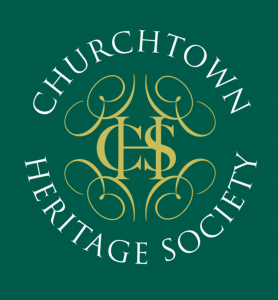The British Library and Churchtown
by Gerry Murphy
The British Library is located on Euston Road just west of King’s Cross Underground station. I visited it and secured a readers pass on Wednesday 18 and Friday 20th April 2001. This is a research library facility and not open to the public though there are public display and exhibition areas. To obtain a readers card you must prove that they hold material that is not readily available in any other library. My case was built on the fact that they hold the original Perceval or Egmont papers and this was accepted with little difficulty.
I used the following areas in the library to conduct my research:
– Humanities Reading Room
– Maps Reading Room
– Manuscripts Reading Room
I started by carrying out various on-line enquiries using key words like:
Churchtown
Bruhenny
Ballintemple
Egmont
Perceval / Percival
When you have completed the on-line searches you must then set about ordering the material you require. You are entitled to look for up to 10 documents which usually arrive at the issue desk after about an hour.
On Day One I started by examining the four volumes of Captain James Grove White’s Topographical and Historical Notes as they relate to North Cork which of course is available in public libraries in Ireland. It was ironic to have gone so far to read about the Standing Stone (Gallaun) on the farm of William Murphy. I also examined the latest volume (1999) of Burke’s Peerage and found that the 11th Earl is still described as living at Two Dot Ranch in Nanton, Alberta, Canada.
I then scanned the 6/7 printed volumes of the “Egmont Papers” of the first Earl from the years before and after 1700. As I discovered these printed volumes are easier to follow than the actual manuscripts. They have a very good Foreward.
Day Two was devoted to the Maps and the manuscripts room. I examined the earliest maps of Cork I could find. The earliest I saw were:
c.1685 Map of Corke / Reference 11480.(1).
This map is not that accurate and shows, for instance, Welfestowne (Walshestown), as being North of the village. Churchtown is described as Ballintemple alias Burton. There is a kidney shaped ring around what looks to me like Burton which is the only like feature in the map of the county. I have definitely seen copies of this map for sale before but bought a scanned (photocopying not allowed) copy anyway for 22p (sterling!)
c.1720 Map of Cork / Reference 11480.(7).
This map is more ornate but less detailed. Ballintemple is now dropped in favour of Churchtown alias Burton. Surprisingly for me a name I thought was far more recent – Twopothouse – is shown on this map.
Other maps
I examined a number of 25 inch OS maps which told me nothing I didn’t know already. I also examined Cork (6 sheets). Published in 1811. Reference 11480.(3) which added nothing new. The first ordnance survey maps of 1845, Cork Sheet 7 subs sheets 14, 15 and 16 and Cork Sheet 16 sub sheets 2, 3 and 4 did not offer anything new either.
In relation to maps my next visit must be to the Valuations Office in Dublin to examine Griffith’s maps from 1851.
Manuscripts
The manuscripts area holds the Egmont papers which includes a huge amount of original correspondence to the first Earl. Familiar townlands such as Ballinguile and Burton are peppered throughout the papers. The original documents (not copies) are all there and you can actually go through them yourself. These include everything from letters from prospective tenants to actual marriage settlements and even the original document from Elizabeth 1 (check) granting the lands to John Perceval. Plans for the original Burton Park plus some illustrations of the house are also in the files.
The most important items I came across were:
1. Thomas Moland Survey 1702 / Reference 47043
Thomas Moland’s mapped survey of all the Perceval lands in Cork in 1702 describes Ballintemple as comprising 4,463 Irish acres, 3 roods and 24 perches. Liscarroll comprised 1,698 and 35 perches. There are pages of maps showing all townlands. Annagh is shown but the village is not mentioned in the narrative which suggests how the bog and woodland might be reclaimed. Features such as big houses are actually illustrated on the maps. I ordered facsimiles of the main Churchtown area map plus the accompanying narrative.
2. Watercolour
A beautiful landscape watercolour measuring about 8″ by 4″ is included within a manuscript book reference 47009A at page 27. This is a view from Egmont House (now Sherlocks) and is described by the artist as the view from the Hill of Egmont.
Other miscellaneous references / notes
Ref Particulars
47213 Drawings of Burton
46921 Grant of Burton
47052 Description from 1686
74896 – 74902 Churchtown
47043
47050
47047
8245.aaa.32.(1) Woollen industry (flax?)
10390.i.2 Grove White (4 volumes)
103.k.61 1st Earl seeking Price Edward Island, Canada 1763
212.k.5.(20). 1st Earl marriage settlement
10924.e.1 State of Georgia
010902.ee.3 Correspondence with Bishop Berkeley
719.m.17.(19) “Earthquake” at Charleville in 1697
There are only two references to Burton on the Berkeley letters of no real interest except perhaps the one that refers to the rain!
Lucy, the Countess of Egmont, who sold the Market House to Flannerys died in 1932. She was wife of the 7th Earl, Charles George Perceval.
The Egmont title included “Baron of Burton”.
The “earthquake” at Charleville was reported in a sensational “tabloid” style magazine in 1697 and tells about a bog shifting a number of miles somewhere north of Charleville.




